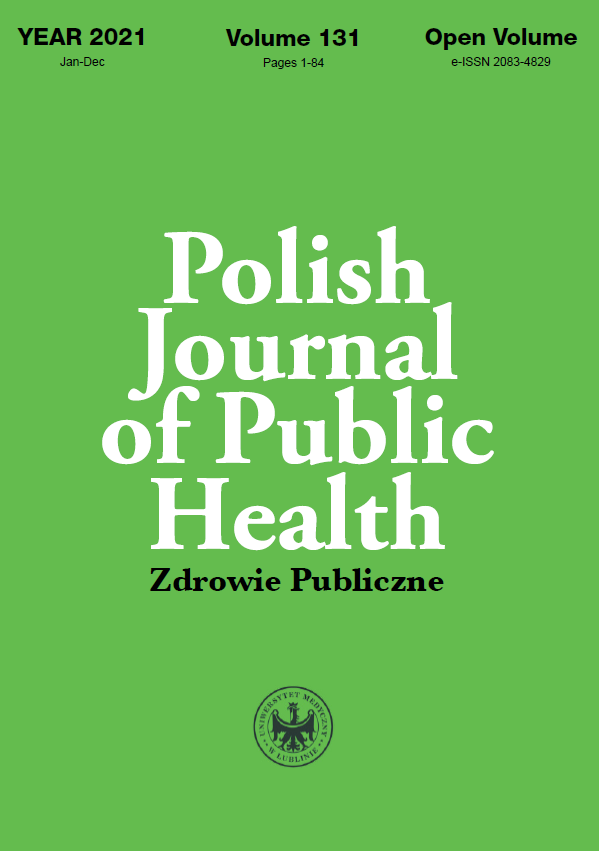Air pollution and emergency department visits for urticaria
DOI:
https://doi.org/10.2478/pjph-2021-0013Keywords:
air pollution, concentration, counts, urban, sex, skinAbstract
Introduction. This study investigates associations between air pollution and emergency department (ED) visits for urticaria in Toronto, Canada.
Aim. To verify the hypothesis that urticaria are related to air pollution.
Material and methods. The National Ambulatory Care Reporting System database is used to draw the daily ED visits. The L50 section of the International Classification of Disease 10th Revision is applied to extract ED visits whose primary causes was urticaria-related skin condition. Statistical models (condition Poisson regression) using daily counts of ED visits are constructed for urticaria (health response) with ambient air pollution concentrations and weather factors as independent variable. Two air quality health indexes and six ambient air pollutants: fine particulate matter PM2.5, O3, CO, NO2, SO2, and maximum 8-hour average ozone are considered as an exposure.
Results. A total of 176 statistically significant (P-Value <0.05) positive correlations were identified over the 15 day lag period (0-14 days). For daily average of ambient ozone, 74 positive correlations were observed with the following relative risks (RR) for a one interquartile range (IQR=12.8 ppb) increase: RR=1.361 (95% confidence interval: 1.302, 1.404), 1.359 (1.299, 1.401), 1.351 (1.281, 1.404) in the warm season (April-September), lag 0, and RR=1.019 (1.013, 1.025), 1.023 (1.016, 1.030), 1.014 (1.007, 1.021), lag 1, in the cold period (October-March), for all, females, and males, respectively. 10, 45 and 45 positive correlations were also obtained for sulfur dioxide, fine particulate matter, and daily maximum 8-hour average ozone concentrations, respectively.
Conclusions. The results indicate that urban ambient air pollution could influence the numbers of ED visits for urticaria. Ambient ozone was determined as the main environmental factor contributing to these associations.
References
1. Zuberbier, T. Urticaria. Allergy. 2003;58:1224-34.
2. Kayiran MA, Akdeniz N. Diagnosis and treatment of urticaria in primary care. North Clin Istanb. 2019;6:93-9.
3. Wedi B, Wieczorek D, Raap U, Kapp A. Urticaria. J Dtsch Dermatol Ges. 2014;12:997-1009.
4. Raciborski F, Klak A, Czarnecka-Operacz M, et al. Epidemiology of urticaria in Poland –nationally representative survey results. Post Dermatol Alergol. 2018;35:67-73.
5. Szyszkowicz M, Porada E, Searles G, Rowe B. Ambient ozone and emergency department visits for skin conditions. Air Qual Atmos Health. 2012;5:303-9.
6. Kousha T, Valacchi G. The air quality health index and emergency department visits for urticaria in Windsor, Canada. J Toxicol Environ Health A. 2015;78(8):524-33.
7. 7. Mrad-Nakhlé M, Farah W, Ziade N, et al. Exposure to fine particulate matter and urticaria: an eco-epidemiological time-series analysis in Beirut. Toxicol Environ Health Sci. 2021;13:175-82.
8. Szyszkowicz M, de Angelis N. Ambient air pollution and emergency department visits in Toronto, Canada. Environ Sci Pollut Res Int. 2021;28:28789-96.
9. Szyszkowicz M, Schoen S, de Angelis N. Air pollution and Emergency Department visits for Disease of the Genitourinary System. Environ Health Insights. 2021;15:1-10.
10. Xu F, Yan S, Wu M, et al. Ambient ozone pollution as a risk factor for skin disorders. Br J Dermatol. 2011;165(1):224-5.
11. Lefebvre MA, Pham DM, Boussouira B, et al. Evaluation of the impact of urban pollution on the quality of skin: a multicentre study in Mexico. Int J Cosmet Sci. 2015;37:329-38.
12. Tseng HW, Lu LY, Shiue YL. Short-term impact of ambient air pollution exposure on daily clinic visits for patients with urticaria in Kaohsiung, Taiwan. Air Qual Atmos Health. 2021;14:1063-70.
13. Valacchi G, Van der Vliet A, Schock BC, et al. Ozone exposure activates oxidative stress responses in murine skin. Toxicol. 2002;179:163-70.
14. Dall-Donne I, Aldini G, Carini M, et al. Protein carbonylation, cellular dysfunction, and disease progression. J Cell Mol Med. 2006;10:389-406.
15. Valacchi G, Fortino V, Bocci V. The dual action of ozone on the skin. Br J Dermatol. 2005;153:1096-100.
16. Pecorelli A, McDaniel DH, Wortzman M, Nelson DB. Protective effects of a comprehensive topical antioxidant against ozone-induced damage in a reconstructed human skin model. Arch Dermatol Res. 2021;313:139-46.
17. JadhavR, Alcala E, Sirota S, Capitman J. Risk factors for acute urticaria in Central California. Int J Environ Res Public Health. 2021;18:3728.
18. He Y, Shi C, Ling F. et al. Short-term effects of outdoor particulate matter pollution on outpatient visits for urticaria in Lanzhou, China. Air Qual Atmos Health. 2021;14:1523-31.
19. Mazur M, Czarnobilska M, Czarnobilska E. Prevalence and potential risk factors of urticaria in the Polish population of children and adolescents. Post Dermatol Alergol. 2020;37:785.
Downloads
Published
Issue
Section
License
Copyright (c) 2021 Authors

This work is licensed under a Creative Commons Attribution-NonCommercial-NoDerivatives 3.0 Unported License.


